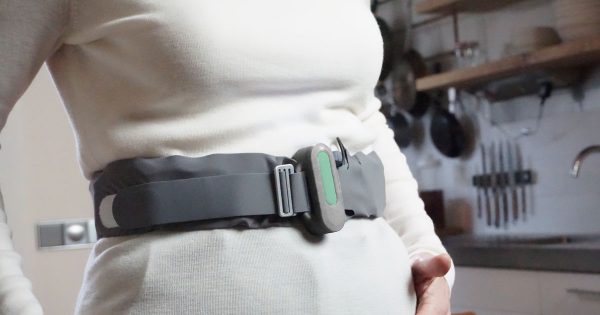
Now that some patients with Bilateral Vestibular Loss (BVL) due to the loss of the balance (vestibular) organs in both ears have trialled wearing the BalanceBelt designed to improve severe unsteadiness, it has led me to reflect on the complexities of balance.
If you’ve sought professional help for a balance disorder, or done some research, you would know that oscillopsia, an illusion of movement of the stationary environment, is the result of bilateral vestibular loss. Some examples of how oscillopsia interferes with everyday activities are:
- jumpy vision during walking
- driving on a bumpy road
- difficulty reading street signs
- recognising a person’s face when walking or travelling in a moving vehicle
- falls
You can see the eye movements of a patient with abnormal VOR in addition to the oscillopsia in this video, below, from the University of Utah.
That said, it is surprising more humans don’t suffer this condition, given how complex the interactions are between the brain and body that underpin our ability to balance.
This ability is one of humanity’s hardest-won evolutionary skills but it involves intensive cognitive and emotional processing.
It’s a complicated system. So lets take a closer look, so to speak.
The inherent instability of standing upright
Did you know that when we are standing upright, we are inherently unstable?
Our bodies are top-heavy, with a small base of support relative to our height, not to mention our centre of gravity is at the height of our pelvis and slightly in front of our ankles.
This is captured eloquently in this quote by Smetacek V from 2002:
“Our ancestors dared to challenge gravity by standing up to it and we continue to do so……..balancing our way onwards and upwards.”
Despite (or because of) this engineering challenge, we manage to balance using an extensive brain-body network which integrates the information from our muscles and joints (proprioception or somatosensory), eyes (vision) and the balance organs (vestibular) in our inner ears.
The muscles in our legs and trunk make the appropriate adjustments to maintain an upright posture.
If we switch off the muscles in our legs, we will fall.
The information from our muscles, joints, eyes, skin, inner ears, and the environment is integrated continuously by our brain – an enormous computational feat.
The cerebellum is thought to be the major player in this process.
In praise of the cerebellum
Our ability to respond quickly to different situations is because the brain makes predictions based on previous experience.
It is thought by some neuroscientists that the cerebellum is involved in these predictions.
The cerebellum is linked to other brain regions such as the motor cortex, which directs movement via neural pathways (closed loops). This means the information is sent back and forth from the motor cortex to the cerebellum thereby processing the information more efficiently and refining the task in hand – motor learning.
Our balance comprises many interconnected parts, because it is challenged in many different ways.
For example, when the vestibular system in our inner ears (bilateral vestibulopathy, or BVL) is affected by infections, trauma, autoimmune disorders, toxic medications such as Gentamicin and Amiodorone or the cause is unknown (idiopathic), the ability to focus with quick head movements and balance is affected.
It’s like watching a homemade movie
Therefore, people with BVL rely heavily on their vision and proprioception to maintain an upright posture.
On uneven surfaces and in dark environments, they fall over because they are unable to make the rapid and required adjustments when walking on uneven surfaces and are disorientated in the dark (specific functions of the vestibular system); hence, patients’ quality of life is reduced, and similarly their daily activities, career, and recreational activities.
Eye-head coordination (gaze stabilisation) is affected too.
For most of us, we move our heads at 2Hz (crossing a road) and can focus to check for oncoming vehicles. Those with BVL have difficulty focussing with quick head movements because the high-speed reflex (loop) connecting the vestibular organs in the inner ears and the six muscles which move our eyeballs (vestibulo-ocular reflex also known as the VOR) is not working. Therefore, people with BVL substitute this loss with alternative strategies, eg, move the head slowly.
We move our heads a great deal, when walking, running, jumping, seated working on a computer and so on. The visual experience of people with BVL is like watching a home-made video or arthouse movie – the world is bobbing/bopping up and down – called oscillopsia.
The BalanceBelt to the rescue
Vibrotactile feedback has been shown to increase the proprioceptive (somatosensory) input for balance control and has been used to reduce the need for visual navigation for fire fighters, military forces, and police officers.
It has been used to support spatial orientation for those who have a visual impairment.
The ambulatory balance belt that we’ve started using, has been shown to increase and improve the proprioceptive perception of verticality in daily life in patients with BVL.
The BalanceBelt is a slim, lightweight belt that gives people who suffer from BVL feedback on their balance and allows them to recover their independence and mobility.

Using the intelligent technology and bio-feedback, the BalanceBelt gives the wearer a sense of direction and support for free movement without any aid.
”‹Helping patients to keep more control over their balance and improving quality of life.
